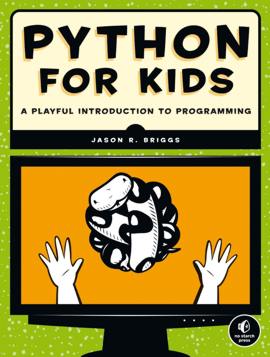| Python for Kids |
Author: Jason R. Briggs With the subtitle "A Playful Introduction to Programming", who should read this book? Jason Brigg's uses Python 3 for this book, which is kind of cool. I think it’s the first beginner book for Python 3 that I’ve read. The text is very readable and the author does a good job of breaking the language down for his readership, especially for the first half of the book. By the time we reach classes, it seems more like a regular beginner book and not one that’s for kids necessarily. The chapters are short and to the point and they have exercises at the end of each one. The author uses the turtle library in some examples in an attempt to make things more interesting. I think this is an interesting approach, but he doesn’t use it in every chapter, so it’s a little inconsistent.
There are also a couple of oddities that are worth being aware of. For example, on page 5, the author states that Python doesn’t use “complicated symbols, like braces ({}), hashes” etc when in fact Python DOES use those. Hashes are used for comments and braces are used for dictionary objects. There’s also some odd naming conventions going on in the book. He describes string substitution (or insertion) as “embedding values”. I’ve never seen it described that way in any other Python book. There’s nothing particularly wrong with describing it that way, but you may not get the best results if you were to search for that topic with those keywords. I think the biggest issue I saw in the text that I read was on page 39 where it described a Python map which the author described as another word for dict. The map command is a built-in Python function that applies a function to each item in an iterable. I think that whole section is poor because the student reading it will think that map and dict are one and the same, and they aren’t even close in the Python world. If the student tries to find examples of a dict by looking up a Python map, they will be very confused!
Enough of my criticisms, let’s take a quick tour of the chapters so you know what you’re getting if you decide to purchase: The book has three parts. The first part is made up of twelve chapters, the first three of which cover variables, tuples, lists, and “maps” (i.e. dictionaries). In Chapter 4 we draw with the turtle library. Then we go back to basics with Chapter 5 talking about conditionals (if/else) and Chapter 6 discussing loops. Chapters 7 and 8 go into Object-Oriented land with functions, classes, modules and objects. Chapter 9 is about some of Python’s built-in functions, but not very many. Chapter 10 appears to be just an overview of the author’s favorite built-in modules, like copy, keyword, random, etc. Chapter 11 goes back to using the turtle module to draw graphics and shapes. Finally, Chapter 12 is a taste of Tkinter, the GUI toolkit that is included with most Python distributions. It looks like the author shows how to draw with Tkinter in much the same way as he did with turtle and also shows a few of Tkinter’s other tricks. In Part II, the author takes some time to teach the reader about games using Tkinter. He uses two chapters to create a game with a bouncing ball and a paddle. Part III is also game-related. This time the author creates a game with stick man using sprites created in GIMP with the game itself built using Tkinter. I’m not sure why you’d use Tkinter instead of something like pyGame, except that pyGame isn’t included with Python. Overall I found this book pretty interesting. If you have a high schooler (or a very brainy middle schooler) then this book might be for your kid! I think this book would also be good as an introductory text on Python in college or just for someone trying to pick up the language. It has a couple of rough edges, but I think those are easy enough to overlook.
If this isn't the Python book for you, here's our list of other Python book reviews.
|
|||
| Last Updated ( Saturday, 23 November 2013 ) |


